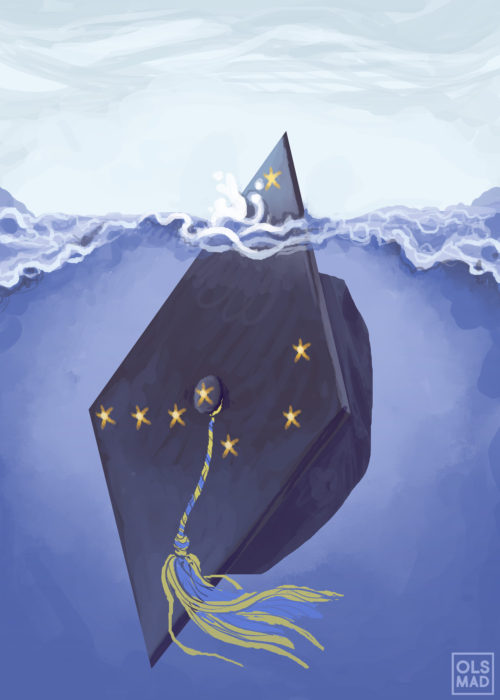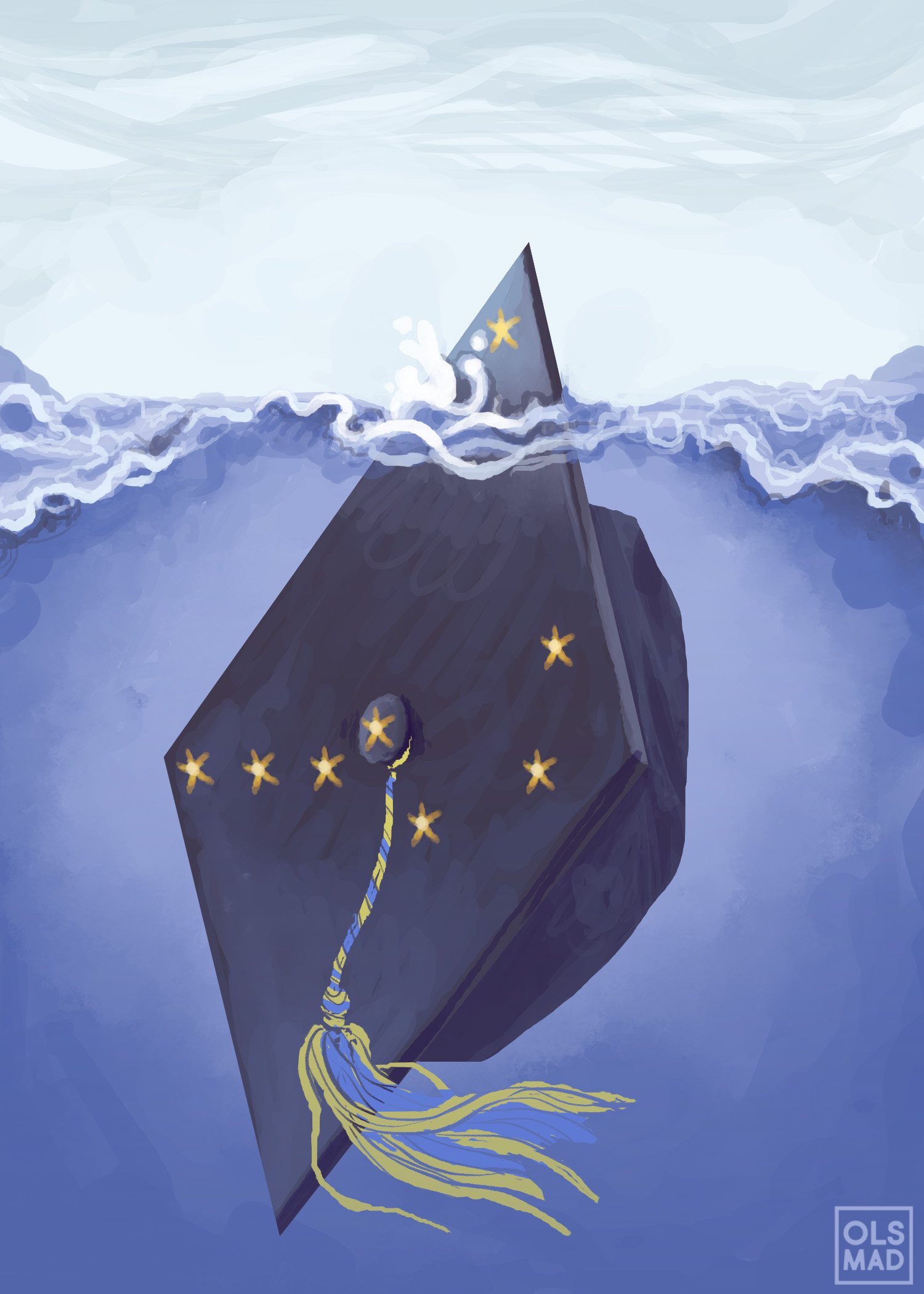
On Monday, students, staff, and faculty will return to the three University of Alaska campuses for the new school year under a cloud of uncertainty. Governor Mike Dunleavy’s proposals to slash Alaska’s budget have centered on cutting funding for higher education, and the summer was fraught with changes to the school’s budget on an almost weekly basis. UA administrators initially stared down a daunting $130 million reduction — more than 40 percent — in state appropriations after Dunleavy vetoed the legislature’s budget at the end of June. But negotiations between the governor and UA’s board of regents last week adjusted the cut down to $25 million this year, with another $45 million reduction over the following two years.
“We’re not trimming fat anymore,” said Kathryn Milligan-Myhre, an assistant professor of microbiology at the University of Alaska Anchorage. “We’re getting rid of the bone and the marrow that makes up the meat of this university.”
After Dunleavy initially vetoed $440 million in spending approved by the state legislature, wrangling between the governor and lawmakers has brought the total cuts down to $200 million. Among the spending reductions were $50 million shaved from Medicaid services, $6.1 million from behavioral health grants, and $7.5 million from Adult Public Assistance payments. The Republican governor justified his vetoes as necessary to balance the state budget without implementing new taxes (Alaska residents don’t pay state income tax or sales tax) or reducing dividends from the state’s Permanent Fund, which uses oil revenue to cut a check to every resident annually. The legislature failed to gain the majority necessary to override Dunleavy’s vetoes.
Alaska is not the only state facing retrenchment in public funding for higher education. “Four out of five states spend less on higher education than they did in 2008,” said Wil Del Pilar, vice president of higher education policy and practice at The Education Trust. Before the cuts, state funding accounted for 36 percent of UA’s budget, and Dunleavy’s vetoes will likely force tuition hikes in the coming years. That’s what happened in Arizona, for example, after state higher-education spending was cut 40 percent per student, from $8,493 in 2008 to $5,025 in 2018. Over that time, tuition at the state’s public universities rose $5,355 on average, according to the Center on Budget and Policy Priorities.
“It’s no surprise that we are seeing this student debt crisis when states are disinvesting [and] tuition is going up. To make up that gap, we are seeing more and more borrowing,” Del Pilar explained.
Although many Alaska students and faculty are relieved that the state funding cuts aren’t as dramatic as originally feared, no one is really sure what will happen next. “It sounds like fall semester is pretty much going to be operating as expected in terms of academics and athletics,” said Jen Ruckle, a graduate student in creative writing and literary arts at the University of Alaska Anchorage. “But obviously there are going to be a lot of changes potentially for spring semester, and nobody’s really told us what that means.”
The university has told her she’ll be able to finish her degree, but Ruckle wonders if she’ll really be able to graduate. “What faculty are going to be left for me to work with? And how are employers going to view my degree because of all that’s going on at University of Alaska?”
Ruckle is not alone in her uncertainty. In July, recent high-school graduates and returning students who were expecting to receive a state scholarship opened their mailboxes to find letters that the program had been defunded. During an emergency meeting in July, the UA board of regents declared financial exigency — a sort of academic bankruptcy. The move allows the regents to make decisions like laying off tenured faculty to keep the university system financially solvent; those decisions are usually reserved for the chancellors at UAA, University of Alaska Fairbanks, and University of Alaska Southeast in Juneau.
There are competing visions for what UA’s future might look like. In July, the board of regents asked system president Jim Johnsen to draft a plan to consolidate the three universities into a single accredited institution. Meanwhile, chancellors of the three campuses put forth an alternative model that preserves individual accreditation while increasing collaboration between the institutions.
As of August 20, the scholarship program had been restored, and the UA board of regents voted to end financial exigency after the governor walked back the most dramatic cuts in negotiations on August 13. The possibility of consolidating the three universities remains on the table.
UAA education policy professor Diane Hirshberg told Bitterroot that it’s not even clear whether the agreement the board made with the governor to cut $70 million over three years is legal. The governor might propose the budget, but the legislature still has to approve it. “He’s telling us what the budget is going to be over the next three years, and asking the university to agree to it. That’s not his function,” she said.
The $70 million cut comes on the heels of decreases in public funding for higher education every year for the last five years. “Since 2014, we’ve been navigating budget reductions from the state,” said Evon Peter, vice chancellor for rural, community and Native education at UAF. “The total impact will be a $121 million reduction of general fund allocation to the UA system [between 2014 and 2023].”
Peter said that his unit has lost more than 50 positions since 2014. “When you think about the level of student support and advising that can happen with 50 fewer individuals, it is definitely having an impact on our ability to deliver quality services,” he said.
Milligan-Myhre, the UAA assistant professor, said that many tenured faculty are working on their CVs, and several of her colleagues have already left UA for other institutions.
“The plans that I’ve seen so far have a reduction of a third of the faculty,” said Milligan-Myhre. “If [consolidation] is the direction of the university, I’m going to have my materials ready in case I have to go on the job market.”
Milligan-Myhre is Alaska Native and doesn’t want to leave the state. “None of us feel secure,” she said. “I do not feel secure in my job. I do not feel secure in the quality of education that we’re going to be able to give to our students.”
UAF student body president Bernard Aoto said that, from the student perspective, the damage has already been done. “Students feel like the administration doesn’t care about their education because we’ve been seeing these cuts happen over and over again,” he said.
Shane Brodie, a University of Alaska Fairbanks alumni who has just returned to Alaska to pursue a graduate degree in arctic and northern studies, questions what consolidation would mean for student services. “We need more student support services, not less, and that is what the ‘one university’ model is proposing,” he said. “It would stretch student support services from one central location across the entire state. Our students need face-to-face mentorship and an email to an advisor that is hundreds of miles away isn’t going to cut it.”
Alaska already faces worker shortages in many fields that require advanced degrees, and further brain drain is a potential outcome of Alaska’s disinvestment in public higher education.
“If Alaska is interested in losing its best and brightest students to other states because they don’t adequately invest in higher ed, then they are making the right choice,” Del Pilar said.
Ruckle, who is Alaska Native, is concerned about that murky future, too — not only for herself, but also for her 15-month-old daughter. “Especially for Alaska Native students, this is their home. They have a right to get an education in their home state,” she said. “On a daily basis, I worry about what my daughter’s educational opportunities are going to look like.”

